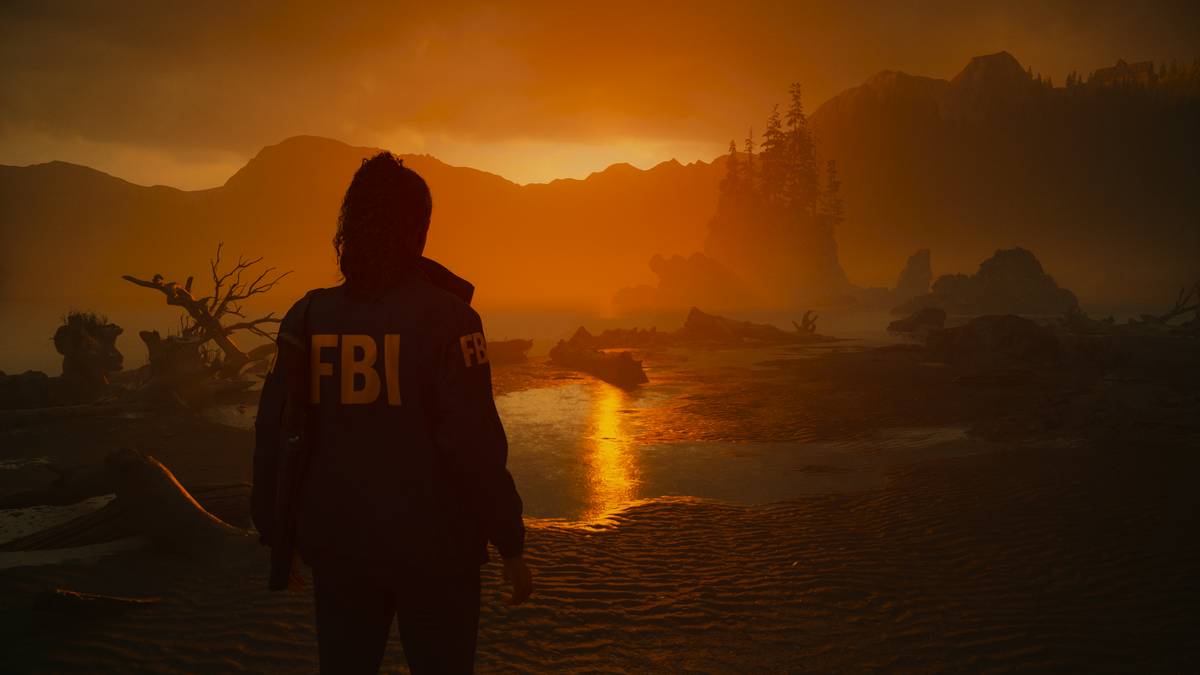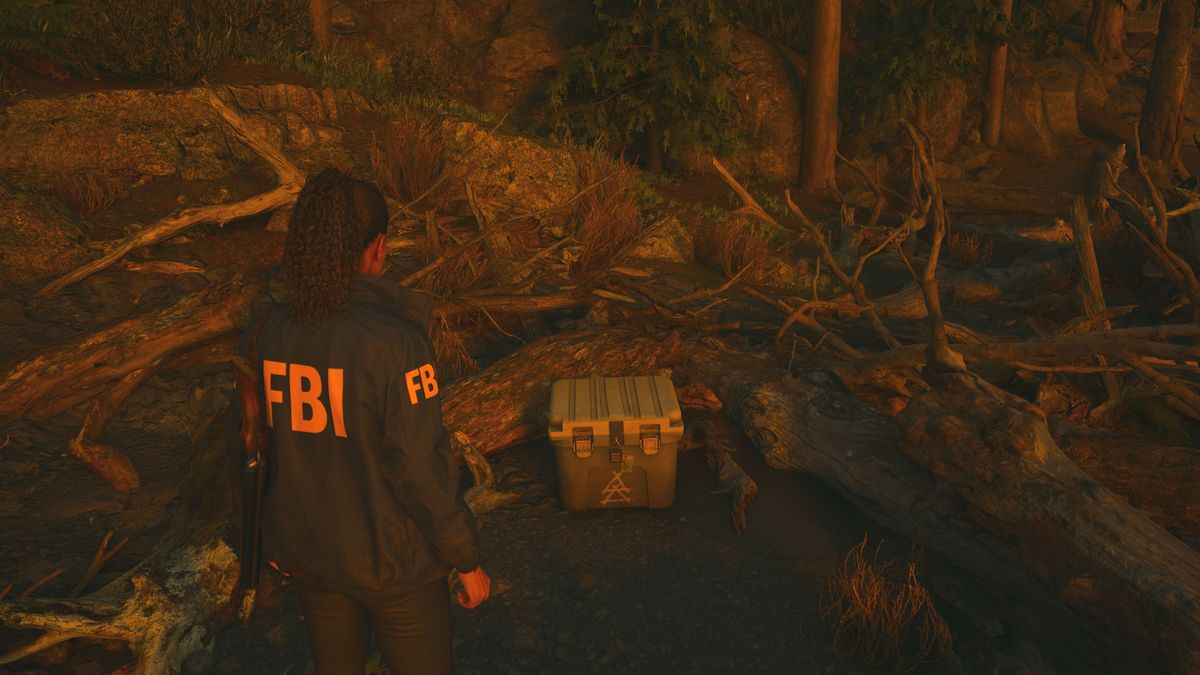At the launch of the RTX 20-series, Nvidia promised “Graphics Reinvented“. That was five years ago, and you could point to various graphical options in games since that were simply not possible before ray tracing acceleration and upscaling came to be. Cyberpunk 2077: Phantom Liberty springs to mind. Yet Alan Wake 2 feels a much more impressive culmination of Nvidia’s RTX technologies—it uses all of them, every technology at once, to look absolutely beautiful.
Alan Wake 2 brings together a lot of rendering techniques, tricks, and technical wizardry to create a game that feels—and I say this as a PC gamer through clenched teeth—next-gen. Dive into the settings menu and you’ll find options for real-time ray tracing, path tracing, Ray Reconstruction, Deep Learning Super Sampling (DLSS), and Frame Generation. The gang’s all here.
For its extensive use of RTX technologies, Alan Wake 2 shines. It’s gorgeously dingy. The lighting from sources across a scene penetrates even the deepest, darkest wood and highlights small details and terrifying scenes I don’t care to talk about. Characters subtlety stand out from their murky environments, and fine details on their clothes occlude others and cast a neat shadow. There’s a surprising vibrance to the deeply disturbing world of Alan Wake 2.
The catch? The game is more dependent on proprietary RTX features than any other I’ve played. This is Nvidia’s dream—it’s the sort of test case that shows off what happens when you get every piece of the rendering puzzle together.
The performance puzzle
Turn off DLSS and Frame Gen and even an RTX 4080 can’t really stomach this game at full bore. That’s not just due to to path tracing, the ‘all-in’ version of ray tracing that more effectively simulates real-world lighting. If you turn ray tracing down to ‘Low’ or ‘Off’ (both of which disable path tracing), performance without upscaling or extra generated frames is still pretty poor.
For best results: add Frame Gen, DLSS Quality, Ray Reconstruction, and ray tracing cranked all the way up to max. Once I let Nvidia’s AI tools take over, I hit a steady 71 fps average at 4K with 1% lows of 54 fps.
That’s the thing: The most gorgeous version of Alan Wake 2 doesn’t work without DLSS. It doesn’t work without Frame Generation. It doesn’t look as good without Ray Reconstruction. This is the future of gaming as Nvidia wants it—no doubt Alan Wake 2 looks superb with everything cranked up to the max, but you need each RTX technology working in sync to reach playable frame rates.
To prove it’s about more than just one single feature alone, you need only look to AMD’s FidelityFX Super Resolution performance in the graph below. Even on Nvidia’s second-best RTX 40-series graphics card, FSR performance is rather dire. You only get close to playable frame rates with path tracing enabled once FSR Ultra Performance mode is switched on, and it’s pretty horrid to look at—Ultra Performance upscales to 4K using a 720p source.
At least higher quality modes of FSR do a better job visually, but there’s still not enough of a performance bump to keep frame rates high without turning down other options elsewhere.
AMD offers just one piece of the performance puzzle in Alan Wake 2 with FSR, and it’s nowhere near powerful enough to counteract the weight of Alan Wake 2’s gorgeous visuals. You need all the other pieces to get it all working properly as one.
I ran the same benchmarks on an AMD Radeon RX 7900 XT, and the results aren’t pretty. Performance is trash if you naively leave ray tracing enabled, or the game looks noticeably worse off if you sensibly disable it. This isn’t some piece of crap card, remember—this is the second-best of AMD’s latest generation.
Test rig
CPU: Intel Core i5 14600K
Motherboard: Asus ROG Strix Z690-F Gaming WiFi
Memory: G.Skill Trident Z5 Neo DDR5-6000 CL30 2x 16GB
Storage: 2TB Sabrent Rocket 4.0 Plus
Cooler: Asus ROG Ryujin II
PSU: Gigabyte Aorus P1200W
To play Alan Wake 2 on an AMD graphics card, you’re left with only one real option: turn all the settings down a notch or three.
We’ve seen large performance deltas between these two GPU manufacturers on a per-game basis before, and it’s not only Nvidia cards that benefit. But you really notice it in Alan Wake more than most—AMD’s high-end doesn’t feel very high-end.
The game is even quite punishing if you’re using an RTX 30-series graphics card, like the RTX 3080 10GB I’ve stuffed in the test rig.
A gorgeous, and exclusive, showcase
I find it difficult to make my mind up about the whole experience. This sort of AI acceleration deeply embedded in a game to produce excellent visuals you couldn’t necessarily mimic without: it’s pushing gaming graphics forward, right? Remedy has aggressively embraced some specific technologies to enable very cutting-edge graphics features here.
It’s clearly thirsty work for any graphics card, however, and proprietary features on the fastest cards from Nvidia appear the best, perhaps only, way to fix that.
On the flipside, as a mostly AMD graphics gamer myself, I don’t like it much when these proprietary features are so crucial to the whole experience and I’m excluded from the path tracing party. I guess that’s nothing new—you don’t buy a modern AMD graphics card and expect to turn ray tracing to the max. AMD does offer frame gen, upscaling, and okay-ish ray tracing support, but I’m missing out on the kind of technology showcase that Alan Wake 2 appears to be for Nvidia’s latest generation.
For those with an RTX 40-series graphics card (at least a relatively high-end one), Alan Wake 2 proves itself to be an excellent way to test your graphics card’s metal and unlock the performance you paid for. For everyone else, you can tone back the graphics settings and still have a perfectly enjoyable experience—much like in Cyberpunk 2077, you don’t need ray tracing to have a good time.
But, sometimes, it helps.


